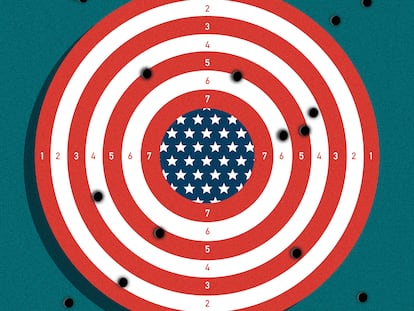Polls on social media deliberately distort political reality
A study concludes that they are carried out mostly by older men, that more bots participate than real users, and the results are more biased before than after elections

Social networks are so widespread among the population that, sometimes, there are those who confuse the opinions expressed there with those of society itself. Some politicians tend to make that mistake as well, taking the debates generated in this virtual environment as a kind of pulse of society (as long as it favors their own intentions). A group of researchers set out to determine the real impact of polls on X, the former Twitter, on the political life of countries. Their conclusions, published this week, show that these polls are tremendously biased: they deliberately distort political reality, mostly to the benefit of the most conservative options. And they are often adulterated with votes purchased from troll farms.
It has been proven that social media overrepresents the opinions expressed by the most reactionary and polarized users. It is also known that the demographics of X users, like those of all social networks, are not representative of society, and that bots — accounts that spread disinformation — and foreign influence further adulterate the final picture. “But there was still no serious study on the extent to which social media polls are used in election campaigns and what their real impact is on those campaigns,” says the paper’s lead author, Przemyslaw A. Grabowicz, assistant professor at the University of Massachusetts Amherst.
Introduced in 2015, a year before the elections won by Donald Trump, and widely used in election campaigns, X polls can be created by any user and shared with others. In recent years, they have become a particularly successful feature of X due to their ease of use and great scope, sometimes amassing millions of votes. Grabowicz and his team estimate that around one million surveys of all types are carried out every month. Shortly after purchasing Twitter in October 2022, Elon Musk used polls, or so he said, to make relevant business decisions, including the firing of the platform’s then-CEO, Parag Agrawal.
The influence of polls
Scientific literature has shown that conventional polls can influence how people perceive public opinion and shape the way each person creates their own views. Does the same thing happen with polls developed on social networks? To find out, Grabowicz and his colleagues assembled a large database of Twitter polls gauging support for U.S. presidential candidates during the 2016 and 2020 election campaigns.
“In the 2020 presidential elections, more than 13,000 opinion polls were carried out on X/Twitter, which collected more than 20 million votes cast,” says Grabowicz. “These polls gave Trump a landslide victory, when in reality it was Biden who won the election. We wanted to look closer, to see if the polls were legitimate and what they could tell us about how social media influences American politics,” he explains. If we had trusted the forecasts collected by these tools, Trump would have won the 2020 election with 58% of the votes. It was not like that: Joe Biden won with 51.3% of the votes and Trump achieved the support of 46.8% of voters.
The first task was to filter the polls. Many of them allowed people to vote on almost anything (if you prefer jazz or heavy metal, if you like pizza over tacos...), so the researchers selected about 7,000 in which the poll explicitly asked “Who will you vote for?” or “Who will win the elections?”

Grabowicz and his colleagues also found that there were 50% more votes of questionable identity (bots) in pre-election polls than in post-election polls. “This suggests that biasing social media polls is a deliberate tactic to influence political outcomes,” the researchers emphasize. In this sense, the now official candidate of the Republican Party for this year’s presidential election, Donald Trump, has shared on his own platform, Truth Social, the results of some X surveys that show him as the favorite with 70% support, presumably to create the impression of his overwhelming popularity.
The polls carried out in 2016 and 2020 not only overwhelmingly gave Trump a victory, they were also twice as likely to have been created, answered and retweeted by men. Regarding the ideology of the participants, conservatives outnumbered liberals 10 to one.
The analysis by Grabowicz’s team also revealed that at least 2,000 polls were conducted after the 2020 election that assumed there had been electoral fraud. “The opacity of Twitter polls makes it difficult to estimate the effect of bias, whether due to misinformation or disinformation,” the authors maintain.
What will happen in 2024?
The average of the political polls carried out in X about the 2024 election give Trump a comfortable victory, with 72% of the votes. Grabowicz and his team have developed a website where users can follow the forecasts given by social polls and see what results they would show if the biases were corrected.
The study coordinated by Grabowicz focuses on one country, the United States, and on one social network in particular, X. Although the authors emphasize that their conclusions cannot be extrapolated to other contexts, it is difficult to ignore the red flags they detect.
“Our work warns that social media lacks transparency, even for things as important as national elections,” says Grabowicz. “If that happens in a context like this, we can be sure that it will also happen in many others.”
Sign up for our weekly newsletter to get more English-language news coverage from EL PAÍS USA Edition
Tu suscripción se está usando en otro dispositivo
¿Quieres añadir otro usuario a tu suscripción?
Si continúas leyendo en este dispositivo, no se podrá leer en el otro.
FlechaTu suscripción se está usando en otro dispositivo y solo puedes acceder a EL PAÍS desde un dispositivo a la vez.
Si quieres compartir tu cuenta, cambia tu suscripción a la modalidad Premium, así podrás añadir otro usuario. Cada uno accederá con su propia cuenta de email, lo que os permitirá personalizar vuestra experiencia en EL PAÍS.
¿Tienes una suscripción de empresa? Accede aquí para contratar más cuentas.
En el caso de no saber quién está usando tu cuenta, te recomendamos cambiar tu contraseña aquí.
Si decides continuar compartiendo tu cuenta, este mensaje se mostrará en tu dispositivo y en el de la otra persona que está usando tu cuenta de forma indefinida, afectando a tu experiencia de lectura. Puedes consultar aquí los términos y condiciones de la suscripción digital.
More information
Archived In
Últimas noticias
Most viewed
- Sinaloa Cartel war is taking its toll on Los Chapitos
- Reinhard Genzel, Nobel laureate in physics: ‘One-minute videos will never give you the truth’
- Oona Chaplin: ‘I told James Cameron that I was living in a treehouse and starting a permaculture project with a friend’
- Why the price of coffee has skyrocketed: from Brazilian plantations to specialty coffee houses
- David King, chemist: ‘There are scientists studying how to cool the planet; nobody should stop these experiments from happening’











































